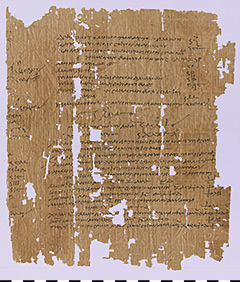BGU I 1 + 337 = Chrest.Wilck. 92 = P.Louvre I 4 Kol. I-II (P. 6826 + 7412)
Anyone annoyed today about the troubles of accounting can be reassured, because in antiquity, it was also necessary to keep a detailed record of income and expenditure. Among other texts, the very rare fragment of a temple bookkeeping account presented here explains the various tax payments and expenditures. Here first the expenditure in money and afterwards those in nature were listed, everything is indicated exactly in drachmas or wheat. Unfortunately, the list of revenues that preceded this list has not been preserved. The document can be dated to the time before AD 166 and is written in Greek.
The papyrus comes from Soknopaiou Nesos, later belonged to the private collection of the Egyptologist Heinrich Brugsch and came to the Berlin Papyrus Collection in 1891. The place Soknopaiou Nesos, whose name means “island of (the god) Soknopaios” – the main god of this place – is located in the Fayum-Oasis and is known today as Dime. Located near Lake Moeris, it was the site of many demotic and Greek papyri. The place is mentioned for the first time in 240 BC, but probably there was a settlement before that. After the heyday of the town in the 1st and 2nd centuries AD, the sources originating from or referring to the site dried up in the 3rd century AD. Since the beginning of the 20th Century, there are regular excavations, since 2001 they are run by the Soknopaiou-Nesos-Project of the University of Salento (Lecce).
This papyrus contains the book of accounts of the sanctuary of the god Soknopaios in Soknopaiou Nesos. Further fragments, which are today in the Louvre in Paris and continue this text in the Berlin Papyrus Collection. The surviving text on the Berliner Papyrus consists of two columns. The first 42 lines deal with expenditure in money, the following lines list expenditures in kind (wheat).
Among the money spent are the particularly large amounts for the head of the priests and the ‚altars‘ of the goddess Isis in the manifestations of Nepherses and Nephremmis in Neiloupolis at the eastern end of Lake Moeris, which in both cases had to be paid to the tax authorities. The ‚altars‘ are probably small shrines. There are various tax payments to other finance departments, e.g. those which concern people who cure meat,for greengrocers and scrubbers. The end of this section with the expenditures for perfume, ointments and the clothing of the gods is particularly interesting. The gods were dressed and made up on three particular days of the year. Finally, the expenses are summed up in money and the remaining income is calculated.
The second section deals with expenditures in wheat. These wheat payments represented expenses paid to priests for special services, e.g. during certain festivals, which are listed here individually. At the beginning of this second list, the Berliner Papyrus breaks off. The fragments in the Louvre in Paris continue with many more religious festivals.
Thanks to the survival of this book of accounts from the sanctuary of the god Soknopaios, we get a detailed insight into the religious calendar, but also in the levies required especially by the state, which are meticulously documented here.



